利用者:にょきにょき/sandbox/ておぶろま
| このテンプレートは廃止されました。 「Template:生物分類表」を使用してください。 Template:Taxobox name | ||||||||||||||
|---|---|---|---|---|---|---|---|---|---|---|---|---|---|---|
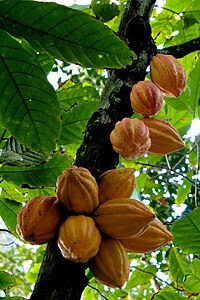 Cacao fruits on the tree
| ||||||||||||||
| 分類 | ||||||||||||||
| ||||||||||||||
| Theobroma cacao L. |
Theobroma cacao also cacao tree and cocoa tree, is a small (4–8 m (13–26 ft) tall) evergreen tree in the family Malvaceae,[1] native to the deep tropical regions of Central and South America. Its seeds, cocoa beans, are used to make cocoa mass, cocoa powder, and chocolate.[2]

Description
[編集]Leaves are alternate, entire, unlobed, 10–40 cm (3.9–15.7 in) long and 5–20 cm (2.0–7.9 in) broad.
The flowers are produced in clusters directly on the trunk and older branches; this is known as cauliflory. The flowers are small, 1–2 cm (0.39–0.79 in) diameter, with pink calyx. The floral formula is ✶ K5 C5 A(5°+5²) G(5).[3] While many of the world's flowers are pollinated by bees (Hymenoptera) or butterflies/moths (Lepidoptera), cacao flowers are pollinated by tiny flies, Forcipomyia midges in the order Diptera.[4] The fruit, called a cacao pod, is ovoid, 15–30 cm (5.9–11.8 in) long and 8–10 cm (3.1–3.9 in) wide, ripening yellow to orange, and weighs about 500 g (1.1 lb) when ripe. The pod contains 20 to 60 seeds, usually called "beans", embedded in a white pulp. The seeds are the main ingredient of chocolate, while the pulp is used in some countries to prepare refreshing juice, smoothies, jelly, and nata.[5] The fermented pulp, until recently discarded in Ecuador, Dominican Republic and Peru, is now being distilled there into a popular alcoholic beverage sold in the United States.[6] Each seed contains a significant amount of fat (40–50%) as cocoa butter. Their most noted active constituent is theobromine, a compound similar to caffeine.
Taxonomy and nomenclature
[編集]Cacao (Theobroma cacao) belongs to the genus Theobroma classified under the subfamily Sterculioidea of the mallow family Malvaceae. Cacao is one of 22 species of Theobroma.
NOTE: Study below deals with cacao germplasm, not taxonomy, not sure if it's even relevant:
In 2008, researchers proposed a new classification based upon morphogeographic and genomic criteria: 10 groups have been named according to their geographic origin or the traditional cultivar name. These groups are: Amelonado, Criollo, Nacional, Contamana, Curaray, Cacao guiana, Iquitos, Marañon, Nanay, and Purús.[7] The generic name is derived from the Greek for "food of the gods"; from θεος (theos), meaning "god," and βρῶμα (broma), meaning "food".
The specific name cacao is derived from the native name of the plant in indigenous Mesoamerican languages. The cacao was known as kakaw in Tzeltal, K’iche’ and Classic Maya; kagaw in Sayula Popoluca; and cacahuatl[疑問点] in Nahuatl.
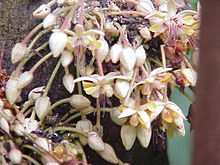
Cupuaçu, Theobroma grandiflorum, is a closely related species found in Colombia, Peru, Bolivia and Brazil. Like cacao, it is also the source for a kind of chocolate known as cupulate or cupuaçu chocolate.[8] Cupuaçu is considered as having high potential by the food and cosmetics industries.
Distribution and domestication
[編集]T. cacao is widely distributed from southeastern Mexico to the Amazon basin. There were originally two hypotheses about its domestication; one said that there were two foci for domestication, one in the Lacandon area of Mexico and another in lowland South America. More recent studies of patterns of DNA diversity, however, suggest that this is not the case. Motomayor et al.[9] sampled 1241 trees and classified them into 10 distinct genetic clusters. This study also identified areas, for example around Iquitos in modern Peru, where representatives of several genetic clusters originated. This result suggests that this is where T. cacao was originally domesticated, probably for the pulp that surrounds the beans, which is eaten as a snack and fermented into a mildly alcoholic beverage.[10] Using the DNA sequences obtained by Motomayor et al. and comparing them with data derived from climate models and the known conditions suitable for cacao, Thomas et al. have further refined the view of domestication, linking the area of greatest cacao genetic diversity to a bean-shaped area that encompasses the border between Brazil and Peru and the southern part of the Colombian-Brazilian border.[11] Climate models indicate that at the peak of the last ice age 21,000 years ago, when habitat suitable for cacao was at its most reduced, this area was still suitable, and so provided a refugium for the species. Thomas et al. speculate that from there people took cacao to Mexico, where selection for the beans took place.
Cacao trees grow well as understory plants in humid forest ecosystems. This is equally true of abandoned cultivated trees, making it difficult to distinguish truly wild trees from those whose parents may originally have been cultivated.
History of cultivation
[編集]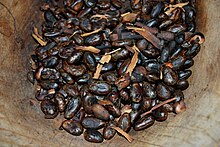
Cultivation, use, and cultural elaboration of cacao were early and extensive in Mesoamerica. Ceramic vessels with residues from the preparation of cacao beverages have been found at archaeological sites dating back to the Early Formative (1900-900 BC) period. For example, one such vessel found at an Olmec archaeological site on the Gulf Coast of Veracruz, Mexico dates cacao's preparation by pre-Olmec peoples as early as 1750 BC.[12] On the Pacific coast of Chiapas, Mexico, a Mokaya archaeological site provides evidence of cacao beverages dating even earlier, to 1900 BC.[12] The initial domestication was probably related to the making of a fermented, thus alcoholic beverage.[13]
Several mixtures of cacao are described in ancient texts, for ceremonial or medicinal, as well as culinary, purposes. Some mixtures included maize, chili, vanilla (Vanilla planifolia), and honey. Archaeological evidence for use of cacao, while relatively sparse, has come from the recovery of whole cacao beans at Uaxactun, Guatemala[14] and from the preservation of wood fragments of the cacao tree at Belize sites including Cuello and Pulltrouser Swamp.[15] In addition, analysis of residues from ceramic vessels has found traces of theobromine and caffeine in early formative vessels from Puerto Escondido, Honduras (1100-900 BC) and in middle formative vessels from Colha, Belize (600-400 BC) using similar techniques to those used to extract chocolate residues from four classic period (circa 400 AD) vessels from a tomb at the Maya archaeological site of Rio Azul. As cacao is the only known commodity from Mesoamerica containing both of these alkaloid compounds, it seems likely these vessels were used as containers for cacao drinks. In addition, cacao is named in a hieroglyphic text on one of the Rio Azul vessels. Cacao was also believed to be ground by the Aztecs and mixed with tobacco for smoking purposes.[要出典]
Currency system
[編集]Cacao beans constituted both a ritual beverage and a major currency system in pre-Columbian Mesoamerican civilizations. At one point, the Aztec empire received a yearly tribute of 980 loads (xiquipil in Nahuatl) of cacao, in addition to other goods. Each load represented exactly 8,000 beans.[16] The buying power of quality beans was such that 80-100 beans could buy a new cloth mantle. The use of cacao beans as currency is also known to have spawned counterfeiters during the Aztec empire.[17]
Mythology
[編集]
The Maya believed the kakaw (cacao) was discovered by the gods in a mountain that also contained other delectable foods to be used by them. According to Maya mythology, the Plumed Serpent gave cacao to the Maya after humans were created from maize by divine grandmother goddess Xmucane.[18] The Maya celebrated an annual festival in April to honor their cacao god, Ek Chuah, an event that included the sacrifice of a dog with cacao-colored markings, additional animal sacrifices, offerings of cacao, feathers and incense, and an exchange of gifts. In a similar creation story, the Mexica (Aztec) god Quetzalcoatl discovered cacao (cacahuatl: "bitter water"), in a mountain filled with other plant foods.[19] Cacao was offered regularly to a pantheon of Mexica deities and the Madrid Codex depicts priests lancing their ear lobes (autosacrifice) and covering the cacao with blood as a suitable sacrifice to the gods. The cacao beverage as ritual was used only by men, as it was believed to be toxic for women and children. [要出典]
Modern History
[編集]
The first Europeans to encounter cacao were Christopher Columbus and his crew in 1502,[要出典] when they captured a canoe at Guanaja[要出典] that contained a quantity of mysterious-looking "almonds". The first real European knowledge about chocolate came in the form of a beverage which was first introduced to the Spanish at their meeting with Moctezuma in the Aztec capital of Tenochtitlan in 1519. Cortez and others noted the vast quantities of this beverage the Aztec emperor consumed, and how it was carefully whipped by his attendants beforehand. Examples of cacao beans, along with other agricultural products, were brought back to Spain at that time, but it seems the beverage made from cacao was introduced to the Spanish court in 1544 by Kekchi Maya nobles brought from the New World to Spain by Dominican friars to meet Prince Philip.[21] Within a century, the culinary and medical uses of chocolate had spread to France, England and elsewhere in Western Europe. Demand for this beverage led the French to establish cacao plantations in the Caribbean, while Spain subsequently developed their cacao plantations in their Venezuelan and Philippine colonies (Bloom 1998, Coe 1996). The Nahuatl-derived Spanish word cacao entered scientific nomenclature in 1753 after the Swedish naturalist Linnaeus published his taxonomic binomial system and coined the genus and species Theobroma cacao.
Traditional pre-Hispanic beverages made with cacao are still consumed in Mesoamerica. These include the Oaxacan beverage known as tejate.
Cultivation
[編集]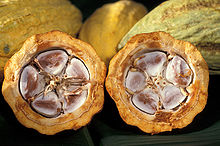



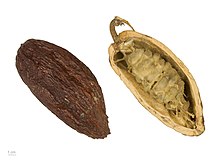
Cacao is cultivated on roughly 17,000,000エーカー (27,000 sq mi; 69,000 km2) worldwide.[22] According to the Food and Agriculture Organization (FAO), the top 20 cacao-producing countries in 2005 were as follows:[23]
| Rank, Country | Value (Int'l $1,000*) |
Production (Metric tons) |
|---|---|---|
| 1 |
1,024,339 | 1,330,000 |
| 2 |
566,852 | 736,000 |
| 3 |
469,810 | 610,000 |
| 4 |
281,886 | 366,000 |
| 5 |
164,644 | 213,774 |
| 6 |
138,632 | 180,000 |
| 7 |
105,652 | 137,178 |
| 8 |
42,589 | 55,298 |
| 9 |
37,281 | 48,405 |
| 10 |
32,733 | 42,500 |
| 11 |
25,742 | 33,423 |
| 12 |
24,646 | 32,000 |
| 13 |
21,950 | 28,500 |
| 14 |
13,093 | 17,000 |
| 15 |
8,472 | 11,000 |
| 16 |
6,547 | 8,500 |
| 17 |
6,161 | 8,000 |
| 18 |
4,352 | 5,650 |
| 19 |
4,336 | 5,630 |
| 20 |
3,851 | 5,000 |
*Based on 1999–2001 international prices
Cacao production has increased from 1.5 million tons in 1983-1984 to 3.5 million tons in 2003-2004, almost entirely due to the expansion of the production area rather than to yield increases. Cacao is grown both by large agroindustrial plantations and small producers, the bulk of production coming from millions of farmers who have a few trees each.[24]
A tree begins to bear when it is four or five years old. A mature tree may have 6,000 flowers in a year, yet only about 20 pods. About 1,200 seeds (40 pods) are required to produce 1 kg (2.2 lb) of cocoa paste.
Historically, chocolate makers have recognized three main cultivar groups of cacao beans used to make cocoa and chocolate.[25] The most prized, rare, and expensive is the Criollo group, the cocoa bean used by the Maya. Only 10% of chocolate is made from Criollo, which is less bitter and more aromatic than any other bean. The cacao bean in 80% of chocolate is made using beans of the Forastero group. Forastero trees are significantly hardier than Criollo trees, resulting in cheaper cacao beans. Trinitario, a hybrid of Criollo and Forastero, is used in about 10% of chocolate. The criollo cacao beans from Chuao in Aragua, Venezuela are widely regarded as some of the finest in the world. In November 2000, the cacao beans coming from said region were awarded an appellation of origin under the title "Cacao de Chuao" (from Spanish-cacao of Chuao)[26] effectively making this one of the most expensive and sought after types of cacao.
A new, genetically based classification of 10 groups[9] may well help breeders to create new varieties that are both pest- and disease-resistant and contain valued flavours.
Major cocoa bean processors include Hershey's, Nestlé and Mars, all of which purchase cocoa beans via various sources.
In June 2009, Mars Botanicals, a division of Mars, launched Cirku, a cocoa extract product that provides cocoa flavanols made with a patented process that contains a high level of phytonutrients.[27]
Pests
[編集]Various plant pests and diseases can cause serious problems for cacao production.[28]
- Insects
- Cocoa mirids or capsids worldwide (but especially Sahlbergella singularis and Distantiella theobroma in West Africa and Helopeltis spp. in Southeast Asia)
- Conopomorpha cramerella (cocoa pod borer - in Southeast Asia)
- Fungi
- Moniliophthora roreri (frosty pod rot)
- Moniliophthora perniciosa (witches' broom)
- Ceratocystis cacaofunesta (mal de machete) or (Ceratocystis wilt)
- Verticillium dahliae
- Oncobasidium theobromae (vascular streak dieback)
- Oomycetes
- Phytophthora spp. (black pod) especially Phytophthora megakarya in West Africa
- Viruses
- Mistletoe
- Rats and other vertebrate pests (squirrels, woodpeckers, etc.)
Conservation
[編集]
The pests and diseases to which cacao is subject, along with climate change, mean that new varieties will be needed to respond to these challenges. Breeders rely on the genetic diversity conserved in field genebanks to create new varieties, because cacao has recalcitrant seeds that cannot be stored in a conventional genebank.[29] In an effort to improve the diversity available to breeders, and ensure the future of the field genebanks, experts have drawn up A Global Strategy for the Conservation and Use of Cacao Genetic Resources, as the Foundation for a Sustainable Cocoa Economy.[30] The strategy has been adopted by the cacao producers and their clients, and seeks to improve the characterization of cacao diversity, the sustainability and diversity of the cacao collections, the usefulness of the collections, and to ease access to better information about the conserved material. Some natural areas of cacao diversity are protected by various forms of conservation, for example national parks. However, a recent study of genetic diversity and predicted climates[11] suggests that many of those protected areas will no longer be suitable for cacao by 2050. It also identifies an area around Iquitos in Peru that will remain suitable for cacao and that is home to considerable genetic diversity, and recommends that this area be considered for protection.
Cacao genome
[編集]
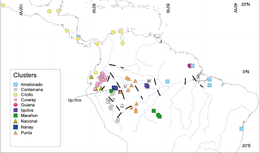 Map showing genetic clusters of Theobroma cacao | |
| NCBIゲノムID | 572 |
|---|---|
| 倍数性 | diploid |
| ゲノムサイズ | 345.99 Mb |
| 染色体数 | 10 pairs |
| 完了年 | 2010 |
The genome of T. cacao is diploid, its size is 430 Mbp, and it comprises 10 chromosome pairs (2n=2x=20). In September 2010, a team of scientists announced a draft sequence of the cacao genome (Matina1-6 genotype).[31] In a second, unrelated project, the International Cocoa Genome Sequencing Consortium-ICGS, co-ordinated by CIRAD,[32] first published[33] in December 2010 (online, paper publication in January 2011), the sequence of the cacao genome, of the Criollo cacao (of a landrace from Belize, B97-61/B2). In their publication, they reported a detailed analysis of the genomic and genetic data.
The sequence of the cacao genome identified 28,798 protein-coding genes, compared to the roughly 23,000 protein-coding genes of the human genome. About 20% of the cacao genome consists of transposable elements, a low proportion compared to other plant species. Many genes were identified as coding for flavonoids, aromatic terpenes, theobromine and many other metabolites involved in cocoa flavor and quality traits, among which a relatively high proportion code for polyphenols, which constitute up to 8% of cacao pods dry weight. The cacao genome appears close to the hypothetical hexaploid ancestor of all dicotyledonous plants,[34] and it is proposed as an evolutionary mechanism by which the 21 chromosomes of the dicots' hypothetical hexaploid ancestor underwent major fusions leading to cacao's 10 chromosome pairs.
The genome sequence will help accelerate research on cacao molecular biology and breeding for elite varieties through marker-assisted selection, in particular for genetic resistance to fungal, oomycete and viral diseases responsible for huge yield losses each year.
Notes
[編集]- ^ “Theobroma cacao”. Encyclopedia of Life. 9 November 2012閲覧。
- ^ Pharmacognosy and Health Benefits of Cocoa Seeds, Cocoa Powder (Chocolate)
- ^ Ronse De Craene, Louis P. (2010-02-04). Floral Diagrams: An Aid to Understanding Flower Morphology and Evolution. Cambridge: Cambridge University Press. p. 224. ISBN 978-0-521-49346-8
- ^ Hernández B, J. (1965). Insect pollination of cacao (Theobroma cacao L.) in Costa Rica. University of Wisconsin.
- ^ “New Products from Theobroma cacao: Seed Pulp and Pod Gum”. New crops, p. 475-478, Wiley, New York 1993.. 2014年1月31日閲覧。
- ^ “Cacao Cocktails: A New Tequila-Like Spirit Distilled From Cacao Fruit”. 2015年3月17日閲覧。
- ^ Juan C. Motamayor, Philippe Lachenaud, Jay Wallace da Silva e Mota, Rey Loor, David N. Kuhn, J. Steven Brown, Raymond J. Schnell (2008). “Geographic and Genetic Population Differentiation of the Amazonian Chocolate Tree (Theobroma cacao L.)”. PLoS ONE 3 (10). doi:10.1371/journal.pone.0003311.
- ^ http://www.fruitipedia.com/cupuacu_theobroma_grandiflorum.htm
- ^ a b Juan C. Motamayor, Philippe Lachenaud, Jay Wallace da Silva e Mota, Rey Loor, David N. Kuhn, J. Steven Brown, Raymond J. Schnell (2008). “Geographic and Genetic Population Differentiation of the Amazonian Chocolate Tree (Theobroma cacao L.)”. PLoS ONE 3 (10). doi:10.1371/journal.pone.0003311.
- ^ Clement, Charles R.; de Cristo-Araújo, Michelly; d’Eeckenbrugge, Geo Coppens; Alves Pereira, Alessandro; Picanço-Rodrigues, Doriane (6 January 2010). “Origin and Domestication of Native Amazonian Crops”. Diversity 2 (1): 72–106. doi:10.3390/d2010072 9 November 2012閲覧。.
- ^ a b Thomas, Evert; van Zonneveld, Maarten; Loo, Judy; Hodgkin, Toby; Galluzzi, Gea; van Etten, Jacob; Fuller, Dorian Q. (24 October 2012). “Present Spatial Diversity Patterns of Theobroma cacao L. in the Neotropics Reflect Genetic Differentiation in Pleistocene Refugia Followed by Human-Influenced Dispersal”. PLoS ONE 7 (10): e47676. doi:10.1371/journal.pone.0047676.
- ^ a b Terry G. Powis, W. Jeffrey Hurst, María del Carmen Rodríguez, Ponciano Ortíz C., Michael Blake, David Cheetham, Michael D. Coe & John G. Hodgson (December 2007). “Oldest chocolate in the New World”. Antiquity 81 (314). ISSN 0003-598X 2011年2月15日閲覧。.
- ^ J.S. Henderson 'et al.' (2007). “Chemical and archaeological evidence for the earliest cacao beverages”. Proceedings of the National Academy of Sciences 104: 18937–18940. doi:10.1073/pnas.0708815104.
- ^ (Kidder 1947)
- ^ (Hammond and Miksicek 1981; Turner and Miksicek 1984)
- ^ J. Bergmann (1969).
- ^ S. Coe (1994).
- ^ (Bogin 1997, Coe 1996, Montejo 1999, Tedlock 1985)
- ^ (Coe 1996, Townsend 1992)
- ^ Head 1903, p. ii:(frontispiece)
- ^ (Coe and Coe 1996)
- ^ http://findarticles.com/p/articles/mi_m1134/is_6_112/ai_105371465/pg_3/ CBS Interactive Business Network
- ^ FAO.org
- ^ Anon. “A strategy to safeguard the future of chocolate”. Bioversity International. 9 November 2012閲覧。
- ^ All about Chocolate -- Varieties
- ^ http://www.wipo.int/ipadvantage/en/details.jsp?id=2618
- ^ Cocoa-derived Cirku launched for better circulation
- ^ “Cocoa Crop Protection”. 9 November 2012閲覧。
- ^ “Cacao Collections”. CacaoNet. 9 November 2012閲覧。
- ^ A Global Strategy for the Conservation and Use of Cacao Genetic Resources, as the Foundation for a Sustainable Cocoa Economy
- ^ The Cacao Genome Database Project. Retrieved September 24, 2010
- ^ The International Cocoa Genome Sequencing Consortium federates efforts from circa 20 different institutions from six countries (France, USA, Côte d’Ivoire, Brazil, Venezuela and Trinidad et Tobago). Financing comes from several public and private sources from France, USA and Venezuela, among which the chocolate brands VALRHONA (France) and HERSHEY’S (USA). See : http://www.cirad.fr/actualites/toutes-les-actualites/communiques-de-presse/2010/decryptage-du-genome-du-cacaoyer
- ^ Xavier Argout, Jerome Salse, Jean-Marc Aury, Mark J Guiltinan, Gaetan Droc, Jerome Gouzy, Mathilde Allegre, Cristian Chaparro, .. & Claire Lanaud (2011). “The genome of Theobroma cacao.”. Nature Genetics 43 (2): 101–108. doi:10.1038/ng.736. PMID 21186351.
- ^ Olivier Jaillon, Jean-Marc Aury, Benjamin Noel, Alberto Policriti, Christian Clepet, Alberto Casagrande .. & Patrick Wincker (2007). “The grapevine genome sequence suggests ancestral hexaploidization in major angiosperm phyla.”. Nature 449 (7161): 463–467. doi:10.1038/nature06148. PMID 17721507.
References
[編集]- Coe, Sophie D. (1994). America's First Cuisines. Austin: University of Texas Press. ISBN 0-292-71155-7
- Coe, Sophie D.; Michael D. Coe (1996). The True History of Chocolate. London: Thames & Hudson. ISBN 0-500-01693-3
- Dienhart, John M. (1997年). “The Mayan Languages- A Comparative Vocabulary” (electronic version (PDF)). Odense University. 2007年2月14日閲覧。
- McNeil, Cameron (editor) (2006). Chocolate in Mesoamerica: A Cultural History of Cacao. Gainesville: University of Florida Press. ISBN 0-8130-2953-8
- Bergmann, John (1969). “The Distribution of Cacao Cultivation in Pre-Columbian America”. Annals of the Association of American Geographers 59: 85–96. doi:10.1111/j.1467-8306.1969.tb00659.x.
- Head, Brandon (1903). The Food of the Gods: A Popular Account of Cocoa. London: R. B. Johnson. p. ii
- Motamayor, J. C.; Risterucci, AM; Lopez, PA; Ortiz, CF; Moreno, A; Lanaud, C (2002). “Cacao domestication I: the origin of the cacao cultivated by the Mayas”. Heredity 89 (5): 380–386. doi:10.1038/sj.hdy.6800156. PMID 12399997.
- End, M.J., Daymond, A.J. and Hadley, P. (2010). Technical Guidelines for the Safe Movement of Cacao Germplasm. Cacaonet - Bioversity International
- A.B. Eskes and Y. Efron, editors (2006). Global Approaches to Cocoa Germplasm Utilization and Conservation. CFC - ICCO - IPGRI
External links
[編集]この記事の外部リンクはウィキペディアの方針やガイドラインに違反しているおそれがあります。 |
- The food of the Gods – the nature, growth, cultivation, manufacture and history of Cocoa, by Brandon Head, from Project Gutenberg
- International Cocoa Organization (ICCO)- cacao daily market prices and charts are available
- Photographs of cacao plants (detail)
- Theobroma Gallery (Stewart R. Hinsley)
